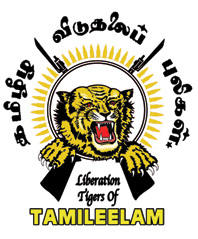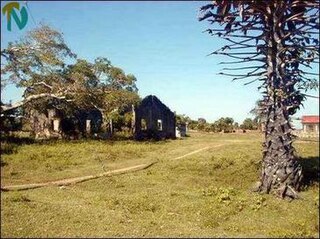| |||||
| Decades: | |||||
|---|---|---|---|---|---|
| See also: | |||||
The following lists events that happened during 1985 in Sri Lanka .
| |||||
| Decades: | |||||
|---|---|---|---|---|---|
| See also: | |||||
The following lists events that happened during 1985 in Sri Lanka .

The Liberation Tigers of Tamil Eelam was a Tamil militant organization, that was based in the northern and eastern Sri Lanka. The LTTE fought to create an independent Tamil state called Tamil Eelam in the northeast of the island in response to violent persecution and discriminatory policies against Sri Lankan Tamils by the Sinhalese-dominated Sri Lankan Government.

The Sri Lankan civil war was a civil war fought in Sri Lanka from 1983 to 2009. Beginning on 23 July 1983, it was an intermittent insurgency against the government by the Liberation Tigers of Tamil Eelam led by Velupillai Prabhakaran. The LTTE fought to create an independent Tamil state called Tamil Eelam in the north-east of the island for the Tamil Sri Lankans.

Kumarapuram massacre refers to the mass murder of 26 Sri Lankan Tamil civilians by the Sri Lankan Army soldiers on 11 February 1996. The victims included 13 women and 9 children below the age of 12. Further 28 civilians were severely injured as well. The event took place in a village called Kumarapuram, located in the eastern district of Trincomalee. It was a notable mass murder of civilians since the resumption of armed conflict between rebel forces and Sri Lankan armed forces since April 1995 during the Sri Lankan civil war. The then-government arrested a number of soldiers and home guards who allegedly carried out the massacre. A court case was started on 2004. On 27 July 2016, the court acquitted six former Army Corporals who were accused of the massacre after they were found not guilty.
The Mavil Aru is a waterway that supplies water to some regions of eastern Sri Lanka. The closing of the sluice gates is considered to be the official beginning of the Eelam War IV although violence including skirmishes and bombings happened before.

Operation Poomalai, also known as Eagle Mission 4, was the codename assigned to a mission undertaken by the Indian Air Force for airdropping supplies over the besieged city of Jaffna in Sri Lanka on 4 June 1987 to support the Tamil Tigers during the Sri Lankan Civil War.
The Anuradhapura massacre occurred in Sri Lanka in 1985 and was carried out by the Liberation Tigers of Tamil Eelam. This was the largest massacre of Sinhalese civilians by the LTTE to date; it was also the first major operation carried out by the LTTE outside a Tamil majority area. Initially, EROS claimed responsibility for the massacre, but it later retracted the statement, and joined the PLOTE in denouncing the incident. The groups later accused the LTTE for the attack. Since then, no Tamil militant group has admitted to committing the massacre. However, state intelligence discovered that the operation was ordered by the LTTE's leader Velupillai Prabhakaran. He assigned the massacre to the LTTE Mannar commander Victor and it was executed by Victor's subordinate Anthony Kaththiar. The LTTE claimed the attack was in revenge of the 1985 Valvettiturai massacre, where the Sri Lanka Army killed 70 Tamil civilians in Prabhakaran's hometown. In 1988, the LTTE claimed that the massacre was planned and executed under the guidance of Indian intelligence agency, RAW.
The Palliyagodella massacre was carried out by the Liberation Tigers of Tamil Eelam (LTTE) against the mostly Muslim population of the Palliyagodella village located on border region of the northern part of Sri Lanka that were controlled by the Tigers at the time. This was the largest massacre of Muslim civilians by the LTTE to date. Village eyewitnesses claim that some 285 men, women and children, around a third of the population, were killed by a 1,000 strong force of the Tamil Tigers; however, the Sri Lankan government states that the LTTE massacred 166 to 171. All but 40 of the victims of the Palliyathidal massacre were Muslim; the rest were Sinhalese.
The October 1995 Eastern Sri Lanka massacres were a series of massacres of the Sinhalese population in the Eastern Province or Sri Lanka carried out by the Liberation Tigers of Tamil Eelam (LTTE) during the Sri Lankan Civil War.
The 2006 Trincomalee Massacre of NGO Workers, also known as the Muttur Massacre, took place on 4 or 5 August 2006, when 17 employees of the French INGO Action Against Hunger were shot at close range in the city of Muttur, Sri Lanka, close to Trincomalee. The victims included sixteen minority Sri Lankan Tamils and one Sri Lankan Muslim.
Eelam War I is the name given to the initial phase of the armed conflict between the government of Sri Lanka and the LTTE.

Eelam War II refers to the second phase of the armed conflict between the Sri Lankan military and the Liberation Tigers of Tamil Eelam, lasting from June 1990 to 1995. The war erupted after the breakdown of peace talks between the LTTE and the government of President Ranasinghe Premadasa, during which mutual distrust and provocations escalated tensions.
Weli Oya,(Sinhala: වැලිඔය, romanized: Weli Oya) is a Sinhalese colony area in Mullaithivu District, Sri Lanka formerly known as Manal Aru. Weli Oya has been affected by the Sri Lankan civil war and government Sinhala colonization programs.
1985 Muttur massacre was a mass killing of Tamil civilians in the town of Muttur in Eastern Province, Sri Lanka. The massacre occurred when all three divisions of the Sri Lankan military attacked the town by land, air and sea. The motive of the attacks was deliberately aimed at slaughtering ethnic Tamils, who formed the local population in the region. The killings lasted from 8 to 10 November of 1985.
Terrorism in Sri Lanka has been a highly destructive phenomenon during the 20th and 21st centuries, especially so during the periods of the Sri Lankan Civil War (1983–2009) and the first (1971) and second JVP insurrections (1987–1989). A common definition of terrorism is the systematic or threatened use of violence to intimidate a population or government for political, religious, or ideological goals. Sri Lanka is a country that has experienced some of the worst known acts of modern terrorism, such as suicide bombings, massacres of civilians and assassination of political and social leaders. Terrorism has posed a significant threat to the society, economy and development of the country. The Prevention of Terrorism Act of 1978 is the legislation that provides the powers to law enforcement officers to deal with issues related to terrorism in Sri Lanka. It was first enacted as a temporary law in 1979 under the presidency of J. R. Jayewardene, and later made permanent in 1982.
The following lists events that happened during 1983 in Sri Lanka.

The 1987 Eastern Province massacres were a series of massacres of the Sinhalese population in the Eastern Province of Sri Lanka by Tamil mobs and Liberation Tigers of Tamil Eelam (LTTE) during the Sri Lankan Civil War. Though they began spontaneously, they became more organized, with the LTTE leading the violence. Over 200 Sinhalese were killed by mob and militant violence, and over 20,000 fled the Eastern Province. The violence has been described as having had the appearance of a pogrom, with the objective of removing Sinhalese from the Eastern Province.